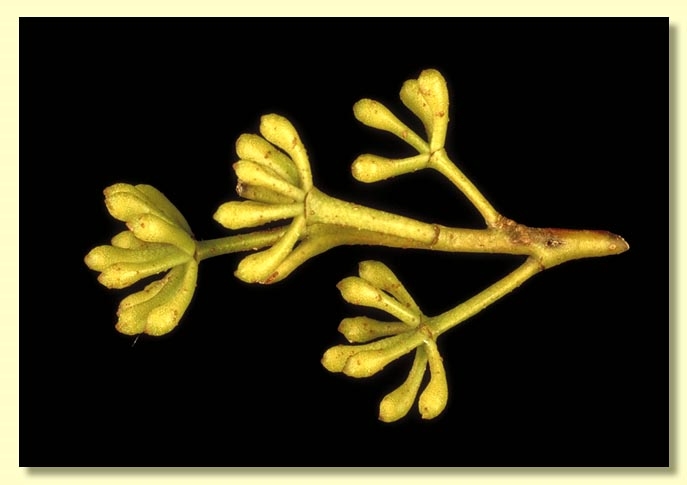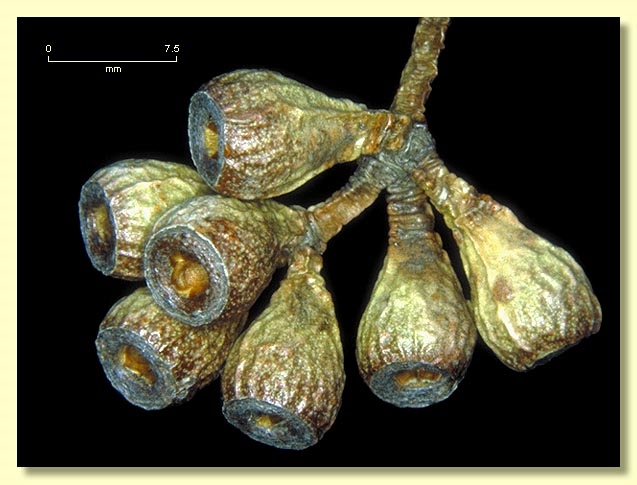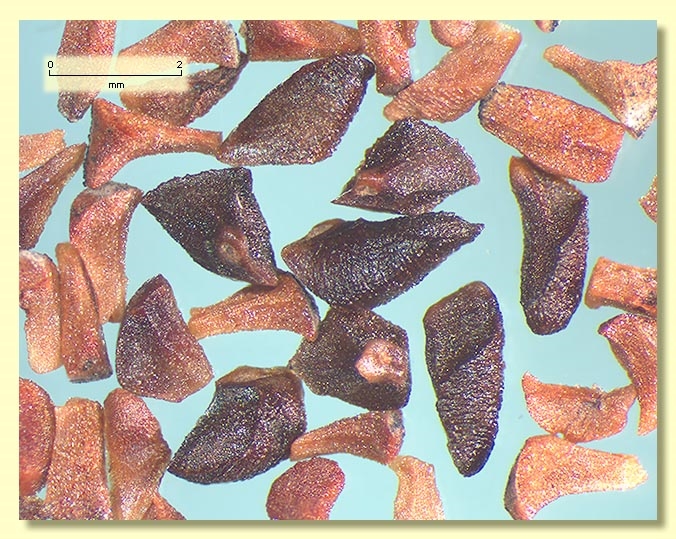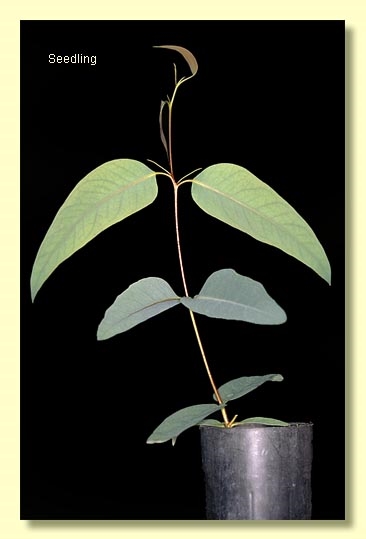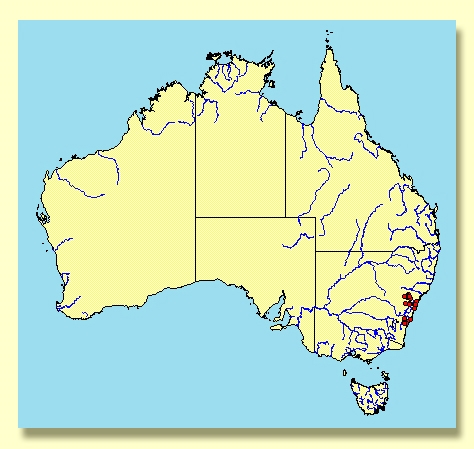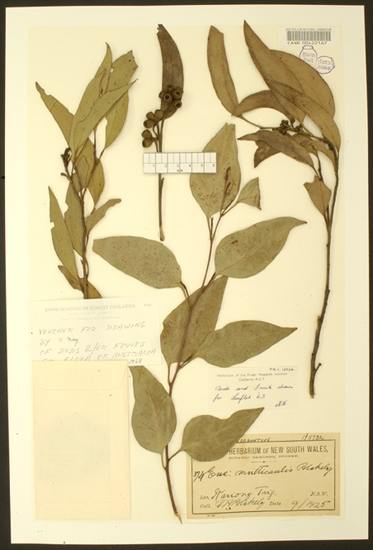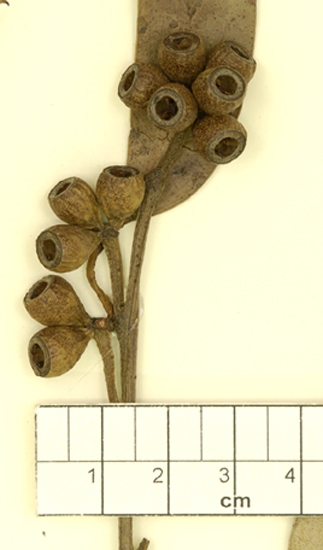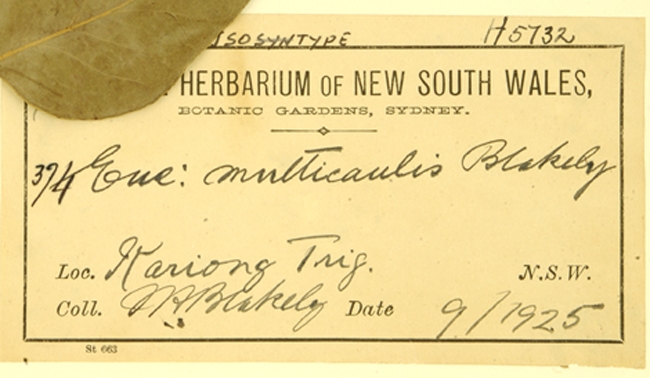Euclid - Online edition
Eucalyptus multicaulis
Eucalyptus | Eucalyptus | Cineraceae | Psathyroxylon | Considenianae
Mallee to 8 m tall. Forming a lignotuber.
Bark smooth throughout or with < 0.5 m of persistent rough bark at the base of stems; smooth bark grey or white; branchlets not glaucous.
Juvenile growth (coppice or field seedlings to 50 cm): stems round in cross-section, sometimes slightly glaucous; juvenile leaves opposite and shortly petiolate for a few nodes then alternate, petiolate, broadly ovate, 5–9.5 cm long, 2–4.5 cm wide, base tapering or oblique, usually blue-green to grey-green.
Adult leaves alternate, petiole 1–2 cm long; blade lanceolate to falcate, 7–15 cm long, 1.4–3 cm wide, base oblique to tapering to petiole, concolorous, glossy, green, side-veins at an acute or wider angle to midrib, reticulation sparse to absent, intramarginal vein parallel to and remote from margin, oil glands island.
Inflorescence axillary unbranched, peduncles 1–1.6 cm long, buds 7 to ?15 per umbel, pedicels 0.4–0.6 cm long. Mature buds obovoid or clavate, 0.3–0.4 cm long, 0.3 cm wide, scar absent, operculum rounded, stamens inflexed, usually with outer staminodes, anthers reniform to cordate, versatile, dorsifixed, dehiscing by confluent slits, style short, stigma blunt, locules usually 4, each with 2 vertical ovule rows on the placenta. Flowers white.
Fruit on pedicels 0.2–0.4 cm long, obconical, 0.7–0.9 cm long, 0.6–0.8 cm wide, not glaucous, disc level to descending, valves usually 4, near rim level or enclosed.
Seeds dark brown to black or grey, 1.6–2.5 mm long, pyramidal or obliquely pyramidal, dorsal surface smooth, hilum terminal.
Cultivated seedlings (measured at ca node 10): cotyledons reniform; stems rounded in cross-section, sometimes slightly glaucous, warty on lower part; leaves opposite, very shortly petiolate, elliptic to lanceolate and discolorous for ca 3 to 5 nodes then alternate, the petioles longer, ovate-lanceolate, 4–12.5 cm long, 2–4 cm wide, base rounded to tapering, becoming concolorous, blue-green to green.
Flowering has been recorded in September, October and November.
A mallee endemic to New South Wales, scattered in the Central Tablelands from east of Rylstone to Putty, south to Royal National Park south of Sydney and further south to the Budawang and Pigeon House Ranges.
Eucalyptus multicaulis is one of two mallees in the blue ash group, the other being E. luehmanniana which differs in the yellow, angular branchlets, thick leaves, strongly flattened peduncles, elongated, yellow or glaucous buds and thick-rimmed, cupular fruit. E. multicaulis has blue-green juvenile leaves but lacks the early glaucescence of its closest relative, E. sieberi, a rough-barked tree.
Eucalyptus multicaulis may be confused with the Wolgan Snowgum, E. gregsoniana, but can be distinguised by the acute side veins in the adult leaves (side veins parallel in E. gregsoniana) and obconical fruit (cupular-hemispherical in E. gregsoniana).
Eucalyptus multicaulis belongs in Eucalyptus subgenus Eucalyptus section Cineraceae series Psathyroxylon having the following characters: cotyledons reniform, juvenile leaves alternate, bluish, adult leaves with side-veins acute, single axillary inflorescences with buds in clusters of seven to 15, buds with single operculum, inflexed stamens, some outer stamens without anthers (staminodes), the remainder with reniform anthers, style short, ovules in two rows, and seeds more or less pyramidal.
Within series Psathyroxylon, E. multicaulis is closely related to E. andrewsii, E. consideniana, E. olida and E. sieberi, differing from all in its mallee habit and essentially smooth bark. The sixth species in this group, the Kangaroo Island endemic E. remota, is also a mallee at times but generally has some rough bark. These six species form subseries Considenianae.




